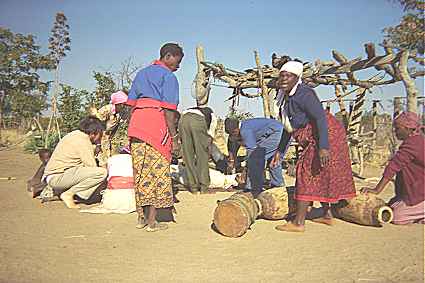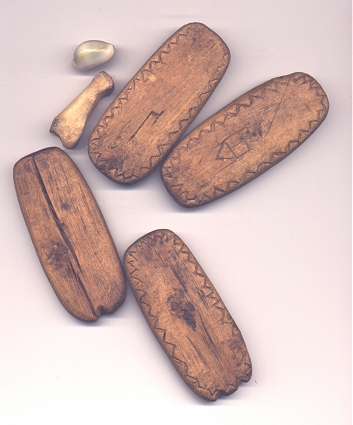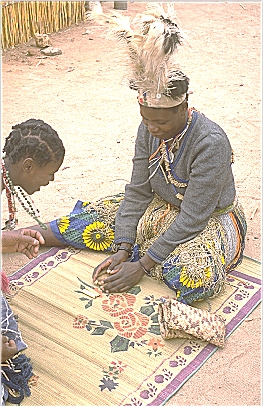
From anthropologist to sangoma in search of an intercultural approach to health
Wim van Binsbergen
 |
Crossing cultural boundaries: From anthropologist to sangoma in search of an intercultural approach to health Wim van Binsbergen |
© 2000-2002 W.M.J. van Binsbergen Haarlem The Netherlands
This article was published under the title
‘Crossing cultural boundaries’ in: Compass
Newsletter: For endogenous development, Number 3, July 2000,
‘Vitality, Health and Disease: In soils, crops, animals and
people’, guest editor Sarshan Shankar, pp. 12-13. Below
follows the authorised version.
In this article I share my personal experiences as an anthropologist, initiated African healer and intercultural philosopher. My experiences and reflections have led me to believe that North Atlantic science cannot claim to have the monopoly of truth. The knowledge and healing experiences of the many therapy systems outside the North Atlantic region must be taken seriously as authentic and valid.
How can we
describe, understand and discuss local knowledge in different
cultures without destroying it in the process? When analysing
local therapy systems and their efficacy, do we have to submit to
the conventions of present-day, North Atlantic social and medical
science?
In the 19th and
20th century, Western medical science spread following the course
set by Western colonialism. Social science, like cultural
anthropology, defined its objectives, theory and methods. North
Atlantic science claims to represent universality, with the
suggestion that this universal truth is lacking in other
scientific, therapeutic and religious traditions.
These other
regional traditions, however, increasingly resent being relegated
to an inferior position. But how can they assert their
independent, original validity without being forced to look at
themselves through the eyes of North Atlantic science?
Born in the
Netherlands, I was trained as an anthropologist and specialised
in religion. My first fieldwork was in 1968 in rural Tunisia,
North Africa, where I studied saint worship and the ecstatic
cult. This is where my struggle with the problem of intercultural
truth, which I now consider to be the central problem of
inter-culturality, began.
During this fieldwork I participated with
gusto; I sacrificed to the dead saints in their graves, danced
along with the ecstatic dancers, experienced the beginning of
mystical ecstasy myself, and built an entire network of fictive
kinsmen around me. Yet in my anthropological writings I reduced
the very same people to numerical values in a quantitative
analysis. Who was I that I could afford to take apart in my
analytical writings the undivided, serious religious and
therapeutic commitment of my research participants? Several of
them played a decisive role in my life as teachers, spiritual
masters, fathers, mothers, siblings, and lovers.
At the time I
knew no other way to describe their religious representations
than as the denial of North Atlantic science. It was only twenty
years later when, in the form of a novel, I found the words to
testify to my love of the North African life forms that I had had
to distance myself from as an anthropologist. Meanwhile, the
two-volume English-language manuscript of my original
anthropological research has lain idle on the shelf.
In 1971 I took
up a teaching job at the University of Zambia. Soon I became
deeply involved in standard-type anthropological fieldwork among
the Nkoya people, a minority group in the western part of the
country. I became increasingly drawn into the study of
traditional healers.
I also studied
local history and kingship, which brough me so close to the local
king that I came to be
considered a member of the royal family. This situation was
formalised when the king died in 1993 and I inherited his royal
bow and arrows, and a large piece of land.
I continued to
work in western Zambia on and off until the mid-1990s. At the
same time I also ventured into other fieldwork locations.
Gradually I came to distance myself from the tradition of
empirical detachment in which I had been trained.
As a result, in
Guinea-Bissau in 1983, I did not only observe the oracular
priests, but became their patient, like almost every other member
of local society. From 1988 onwards I decided to throw overboard some
vital professional, anthropological considerations. Not only did
I become the patient of the local diviner-priests, or sangomas,
but at the end of a long therapy course I became one of them. I
had become a believer in the local collective representations.

Fellow-sangomas supersive one of the principal acts marking van Binsbergen's (left, squatting) initiation as a sangoma: the sacrifice of a goat at the male ancestors'shrine3 in Matshelagabedi village, Botswana
At the time I
justified this as a primarily political deed. As a white man I
was publicly distancing myself from white monopoly capitalism and
racism. Now, more than at the time, I realise that mine was also a
revolt against professional anthropological hypocrisy. It was a
decision which in fact distanced me from cultural anthropology,
and which paved the way for my present commitment to
intercultural philosophy.
For me, this
step liberated me from the narrow Western scientific framework.
After a while, becoming a sangoma myself also liberated me from
the far-reaching spiritual dependence on my mentors and fellow
cult members that had originally characterised my sangoma-hood.
Becoming a local diviner-priest was my personal answer to the
contradictions of the practice of intercultural knowledge
production that had occupied me for decades.
Becoming an
intercultural philosopher meant taking one step further. It
amounts to integrating one’s individual experience into a
systematic and reflective framework in order to explore its
social relevance. For what is at stake here is not merely an
autobiographical anecdote. My struggle with intercultural
knowledge coincides with a similar problem that faces the modern
world where intercultural knowledge production is a major
challenge.
It is possible
for me to be a Botswana diviner-priest, a Dutch professor,
husband and father, and an adoptive member of a Zambian royal
family at the same time. This does not just say something about
me, a tormented, post-modern, boundless person, who has lost his
original home but found new physical and spiritual homes in
Africa. Provided we take the appropriate distance, it also says
something about what ‘culture’ is and what it is not.
It implies that
culture is not tied to a place, not unique but multiple, not
impossible to combine, blend and transgress, not tied to a human body,
an ethnic group, or a birth right. And it suggests that
ultimately we Europeans may be much better off as nomads between
different cultures from all over the world, than as self-imposed
prisoners of Eurocentrism.
In
the 1990s the route from anthropology to intercultural philosophy
led me to a further exploration of the relation between cultures.
Once I had become a sangoma, I had at my disposal a unique body
of cultural knowledge and status as a local religious authority.
But, could I find a new perspective from which my transcultural
position could be combined with a some kind professional
scientific knowledge production?

The wooden tablets which have played a central role in van Binsbergen's intellectual quest
I now possessed
the four mysterious wooden tablets of the sangoma oracle. They
seemed to represent a strictly local cultural phenomenon. It was
as if they had arisen in this Southern African village society
during some indefinite primordial age.
The local oracle
of these tablets had already been described by missionaries some
four hundred years ago. Each of the four tablets had a name:
‘The old woman like a stone’, ‘The old male witch
like an axe’, ‘Itching pubic hair like a young
woman’s’, and ‘The uvula like a youthful
penis’. Their various combinations, when they are ritually
cast, have connotations with witchcraft, ancestors, taboos,
sacrificial dances, and all varieties of local animal totems.
What could be more authentic and more African?
But, to my
surprise, the interpretation scheme and the names of the sixteen
possible combinations of the sangoma tablets could be compared to
tenth century Arabian magic which had featured, just like the
Chinese I Ching, configurations of whole and broken lines.
At the same time their astrological implication had been
elaborated much earlier in Babylonia. I had to accept that the tablet’s
romantic suggestion of extreme African locality was a mere
illusion. Beneath it lurked a reality with enormous consequences
for my theoretical and existential stance as an anthropologist
and world citizen
As a consequence
the local cultural orientation in which the inhabitants of Botswana,
had entrenched themselves, and from which I felt initially
painfully excluded, turned out to be something quite different to
an absolute, unbridgeable otherness.
Instead, like my
own cultural background as a North Atlantic scholar, it was a
distant offshoot of civilisations in the ancient Near East, such
as Babylonia and Egypt. Morover, both North Atlantic scholarship,
and Southern African sangomahood, had been effectively fertilised
by an earlier offshoot from the same stem: the Arabian
civilisation.
For years I had
been struggling with ‘the African culture’ as if it had
been an unassailable, utterly alien totality. Now parts of it
turned out to be familiar, kindred, and available for respectful appropriation.
This insight triggered the start of a comprehensive research
project, which over the years has resulted in several
publications including Black Athena: Ten Years After
(1997) and a book manuscript entitled Global Bee Flight:
Sub-Saharan Africa, Ancient Egypt and the World: Beyond the Black
Athena thesis.
A few years ago
I spent a year as an anthropological member of the Working Group
on ‘Magic and religion in the Ancient Near East’ at the
Institute for Advanced Study (NIAS), in the Netherlands. Here I
was suddenly and quite unexpectedly struck by the various
parallels between the ceremonies and mythologies of the Nkoya
kingship in Zambia and those of Ancient Egypt, Mesopotamia, and
South Asia.
These parallels
were so striking and detailed that I was forced to seriously consider
the possibility of cultural diffusion between these regions and South-central
Africa. Once again there was the suggestion of cultural
continuity in space and time; across thousands of kilometres and
several millennia.
The
tablets of the sangoma divination system in Botswana and Nkoya
kingship in Zambia are two concrete examples of cultural
convergence and diffusion across the Old World. This phenomenon
has occupied a central place in my empirical research since 1990.
Supported
by scholarly literature and the involvement with colleagues and
research students I have developed the hypothesis that
considerable correspondences exist between the different local
cultural orientations. These can stretch far beyond the strictly
local horizons of classic anthropology and far beyond
‘cultures’.
In many respects
the scholarly work I produce today would still qualify as
‘anthropology’. However, it is a kind of anthropology
that is far removed from the way I was trained. Thirty-five years
ago my discipline prescribed that I gaze from a distance at the
local other. The ]knowledge claims based on that distant gaze are
now being increasingly questioned from the perspective of
intercultural philosophy.
My
‘becoming a sangoma’ confirmed, on the level of
personal thought, experience and belief, the possibility of
crossing cultural boundaries in a local therapeutic context. The
outcome of the subsequent historical and comparative studies has
been even more striking, however. They have offered concrete
reasons for believing that the boundaries between the seemingly
unrelated therapy systems across the world are relative and
porous. In addition to being rooted in the shared experience of
the human body and mind, to some degree they share a common
inspiration and intellectual past.

Sangomas in action: The younger sister expresses her genuine surprise at the particular fall of the divination tablets
As a result, I
argue that North Atlantic science cannot claim to have a monopoly
of truth. The experience of knowledge and healing in numerous
other therapy systems should be studied seriously as authentic
and valid, free from the constraints of North Atlantic models.
| page last modified: 04-03-02 18:17:57 |  |